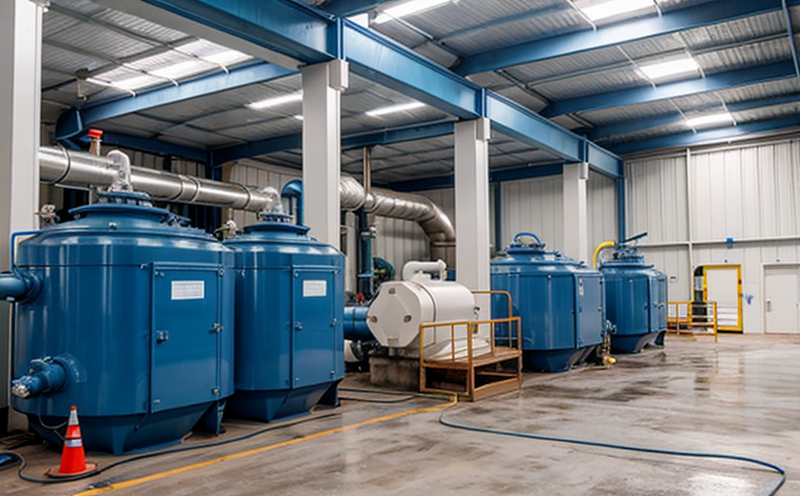ISO 15705 COD (Chemical Oxygen Demand) Testing of Marine Wastewater
The ISO 15705 standard is a critical benchmark for the measurement of Chemical Oxygen Demand (COD) in marine wastewater. This test assesses the amount of oxygen required to degrade organic matter present within wastewater samples, providing insights into water quality and compliance with environmental regulations.
Our laboratory specializes in conducting ISO 15705 COD testing on ballast water and other types of wastewater from maritime operations. This service is essential for ensuring that shipping companies meet the stringent requirements set by international laws like MARPOL Annex I, which mandate the reduction of harmful substances in discharged ballast water.
Our team follows rigorous procedures to prepare samples correctly, ensuring accurate results. The testing process involves collecting representative samples from various ships and ports, transporting them under controlled conditions back to our state-of-the-art laboratory facilities, where they undergo precise analysis using advanced instrumentation such as automated COD analyzers.
The importance of this service cannot be overstated, especially considering the global focus on reducing pollution in oceans. By adhering to ISO 15705 standards, we help clients stay ahead of regulatory changes and maintain their reputation for environmental responsibility.
| Sample Collection | Transportation Conditions | Laboratory Analysis |
|---|---|---|
| Representative samples are collected from various sources aboard ships or at ports. | Samples must be kept cool and away from direct sunlight during transport to prevent degradation of organic matter. | Automated COD analyzers provide rapid, accurate measurements according to ISO 15705 guidelines. |
| Sampling frequency depends on the type of vessel and operational activities. | Packaging materials are chosen based on their ability to maintain sample integrity. | Data from multiple tests is averaged for final reporting, ensuring reliability. |
To ensure consistent results across different types of wastewater, our laboratory has developed standardized protocols that account for variations in composition and concentration levels. These protocols help us deliver accurate COD values even when dealing with complex samples containing high concentrations of organic compounds or heavy metals.
Our expertise extends beyond mere compliance; we offer valuable insights into optimizing ballast water treatment processes based on COD test results. For instance, understanding the efficacy of current treatments helps identify areas for improvement and suggests alternative methods that could lead to better outcomes.
In conclusion, ISO 15705 COD testing is not just a requirement but an opportunity for continuous improvement in maritime operations. Our commitment to precision ensures that every test contributes positively towards maintaining clean seas while supporting sustainable practices within the industry.
Industry Applications
| Application Area | Description |
|---|---|
| Shipping Industry | Ensures compliance with MARPOL Annex I requirements by monitoring ballast water quality. |
| Oceanographic Research | Supports scientific studies on aquatic ecosystems impacted by anthropogenic activities. |
| Marine Pollution Control | Aids in the development and implementation of effective pollution mitigation strategies. |
The shipping industry plays a pivotal role in global trade, making it vital to maintain high standards of environmental stewardship. ISO 15705 COD testing helps monitor the impact of ship-generated waste on marine environments, ensuring sustainable practices and regulatory compliance.
For oceanographic research, accurate COD measurements are crucial for assessing the health of coastal waters. By quantifying organic pollutants, researchers can better understand how human activities affect these delicate ecosystems.
In terms of marine pollution control, this testing method provides essential data that informs policy decisions aimed at minimizing harmful impacts on aquatic life and habitats.
Quality and Reliability Assurance
Maintaining high standards of quality and reliability is paramount in our laboratory. We achieve this through meticulous sample preparation, stringent adherence to ISO 15705 protocols, and the use of cutting-edge analytical equipment.
Our team undergoes regular training to stay updated with industry trends and advancements in COD testing methodologies. This commitment ensures that all tests conducted meet or exceed international standards.
We employ experienced professionals who have extensive experience working within the maritime sector, allowing us to provide tailored solutions for our clients' specific needs. Our quality management system is ISO 9001 certified, ensuring consistent excellence in every aspect of our operations.
Client satisfaction is at the forefront of everything we do. We strive to build long-term relationships by offering reliable services and transparent communication throughout each project.
Use Cases and Application Examples
| Use Case | Description |
|---|---|
| Regulatory Compliance | Assisting clients in meeting MARPOL Annex I requirements by providing accurate COD measurements. |
| Ongoing Monitoring Programs | Implementing regular monitoring programs to track changes over time and ensure sustainable practices. |
| New Treatment Method Validation | Evaluating the effectiveness of newly developed ballast water treatment methods through rigorous COD testing. |
One key use case involves assisting shipping companies in achieving compliance with MARPOL Annex I. By providing precise COD measurements, we enable them to monitor and control the organic load in their ballast water discharges effectively.
We also support ongoing monitoring programs aimed at tracking trends and identifying potential areas for improvement. Regular testing allows stakeholders to make informed decisions about future initiatives designed to enhance environmental protection efforts.
Another important application is validating new treatment methods used in ballast water management systems. Through thorough COD testing, we can assess whether these innovations deliver the desired results and contribute positively towards reducing pollution levels.





